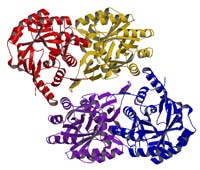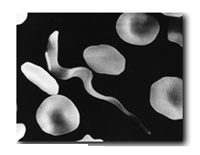This web page was produced as an assignment for an undergraduate course at Davidson College.
Life cycle
The Trypanosoma brucei parasite undergoes mitotic division, but in a very unique way. The cytoskeleton splits according to the direction of the basal body after its initial replication. Since it remains associated with the kinetoplast, this organelle replicates too. The resulting kinetoplasts are separated by the basal bodies. The nucleus undergoes replication as the second flagellum grows. The mitochondria divide and cytokinesis proceeds from the anterior to the posterior portion. The daughter cells may remain connected even after cytoplasmic division is complete.
Mode of infection

Trypanosoma brucei has three sub-species: T.b. brucei, T.b. gambiense, and T.b. rhodesiense. All of three species are parasitic worms that have two hosts. The worm begins life in the gut of an insect, usually the large Tsetse fly that are common in Africa (where the resulting disease: African sleeping sickness) is the most prevalent. Trypanosoma brucei begins in the fly’s gut, where it matures, but then migrates to the salivary glands where, when the fly bites an unsuspecting mammalian host. The parasite then is transferred from the fly to bloodstream of the new host where it then may migrate to other areas. It may also be transferred after maturity from human to human through fluid exchange or blood transfusions. ]
Structure


While this parasite does not use a specific receptor to bind to and infect individual cells, as it instead infects systematically, it does have a coat of variable surface glycoproteins (VSGs). These proteins vary dramatically from cell to cell, thereby enabling the parasite to escape recognition by the innate and adaptive immune responses via a protective barrier and an alternating cell surface. The parasite also boasts a flagellum (attached along the cell body for extra propulsion), allowing it to maneuver through host tissues and evade immunological responses.



Oddities
The parasite has to survive in two very different environments: tsetse fly gut and mammalian blood and therefore must undergo very complex structural changes to thrive in both circumstances. It is in an immature form in the fly gut but matures just before it moves to the salivary glands and is expelled from the fly. This change makes the parasite ideal for infection of a vertebrate host.